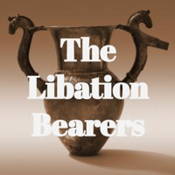
Overview
Synopsis
The Libation Bearers is the second play in the only extant trilogy from Ancient Greece, The Oresteia. Originally presented around 450 BCE at the City Dionysia, The Libation Bearers recounts the story of Orestes’ return to Argos. Compelled by the god Apollo, Orestes is resolved to kill his mother Clytemnestra, and her lover Aegisthus--revenge for their slaughter of Agamemnon, Orestes’ father. This murder is not just vengeance, but also freedom for the people of Argos, who are victims of Aegisthus’ terrible leadership and cruelty. When Orestes arrives in Argos, he sees Electra dressed as a slave, in mourning at her father’s tomb. They siblings reunite, scarcely believing that the other is really there. Then, they set their plan for revenge in motion: By delivering a message that Orestes is dead, the disguised prince will be able to get into the palace and slaughter the tyrannical king and queen. However, Clytemnestra is shrewd and manipulative, and even when her lover is dead won’t give up without a fight. Can Orestes fulfill his revenge and duty to Apollo? Will Clytemnestra still wield power over him? One of the oldest tales in Greek mythology, The Libation Bearers is a tale of deception, revenge, and murder--all in the name of honor.
Show Information
Context
Plot
Characters
| Name | Part Size | Gender | Vocal Part |
|---|---|---|---|
|
Lead |
Male |
Non-singer |
|
|
Lead |
Female |
Non-singer |
|
|
Lead |
Female |
Non-singer |
|
|
Supporting |
Male |
Non-singer |
|
|
Supporting |
Male |
Non-singer |
|
|
Supporting |
Female |
Non-singer |
|
|
Supporting |
Female |
Non-singer |
|
|
Featured |
Male |
Non-singer |
Songs
A song with an asterisk (*) before the title indicates a dance number; a character listed in a song with an asterisk (*) by the character's name indicates that the character exclusively serves as a dancer in this song, which is sung by other characters.
Monologues
Scenes
Key Terms
A recurring character type or symbol representing universal patterns in storytelling, often used in classical and contemporary theatre.
Catharsis is the emotional release experienced by the audience at the conclusion of a tragedy or intense dramatic work. It allows viewers to purge feelings of fear, pity, or tension through the resolution of the play’s conflict. The concept dates back to Aristotle, who believed catharsis was central to the purpose of theatre.
A sudden realization or insight experienced by a character, often marking a turning point.
A group in Ancient Greek theatre that commented on the action, represented the public, and provided narrative insight.
A tragic flaw leading to the downfall of a hero in classical tragedy. This term plays a vital role in understanding theatrical structure and is commonly encountered in stagecraft or performance settings.
The central character in a play, often one who faces conflict and undergoes a journey or transformation. This term plays a vital role in understanding theatrical structure and is commonly encountered in stagecraft or performance settings.
A body of traditional stories involving gods, heroes, and creation myths. Mythology provides inspiration for characters and narratives in global theatre traditions.
A Tragedy is a form of drama that explores human suffering, conflict, and loss, often leading to a disastrous or fatal conclusion. Traditionally, the main character experiences downfall due to a personal flaw, poor judgment, or forces beyond their control. Tragedy aims to evoke pity and fear in the audience, leading to reflection and emotional release.
A protagonist whose downfall results from a fatal flaw, central to classical and modern tragedy.
Videos
Quizzes
Themes, Symbols & Motifs
Sorry! We do not currently have learning modules for this guide.
Quote Analysis
Sorry! We do not currently have learning modules for this guide.
